NEW! FENCES THAT WORK BOOKLET
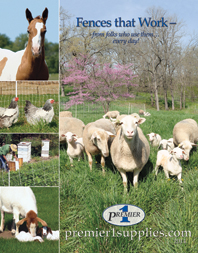 New!
New!
2014 Fence Booklet
Look for it in your mailbox this week. It includes, along with our standard products, the following new items:
HotShock® & IntelliShock® Energizers
(Expected mid-April 2014.)
Low-cost, new design! 0.5, 1, 2 and 3 joule units that use either battery or plug-in power. IntelliShock DC units are variable draw—that means they use less energy when the fence is clean, thus increasing battery life and reducing cost.
Insulators
| • |
Corner Roller—Prevents conductor from slipping off. Smooth roller prevents wear on conductors. Safer—plastic pin breaks if a horse crashes into fence. |
| • |
Double Pigtail Offset—Holds conductors on opposite sides of wooden post. For use with rope and narrow tape. Tolerates moderate up/down strain. |
PREMIER NETTING
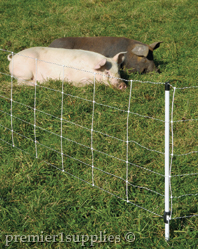
Pasture pigs fenced in by Pig QuikFence™.
Premier is the source of 80% of the USA's electric netting. And we're the world leader for new netting designs and uses!
Why Premier “knows” netting...
| • |
We’ve used it for 44 years (since 1970)—longer than anyone in the US. |
| • |
It’s in use 24/7 at Premier to fence sheep, goats, poultry and dogs in—and to fence deer, coyotes, and stray dogs out. |
| • |
We talk daily to netting users nationwide—who let us know what they like and/or dislike; when it works and when and why it doesn’t. |
| • |
View our Netting Comparison Chart to compare all of our nets. |
We have 3 netting videos available:
ENERGIZERS
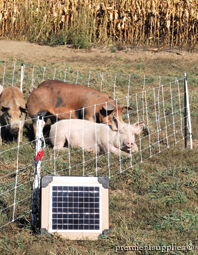
PRS energizers can easily be moved along with a pig's paddock. No extension cords or outlets necessary.
|
PRS Solar Energizers
Which unit is right for you?
The size, in pulse energy output (range from .5 joule to 2 joules), depends almost entirely on the weed contact that will occur and the length of the fence.
Contact Premier or call 800-282-6631 to speak with one of our fence consultants to help you determine the best energizer for your needs. We have a unique 2-year rapid replacement warranty on all of our energizers.
You can also view our energizer comparison charts online or in Premier's fencing catalog to help in choosing an energizer.
|
 |
 |
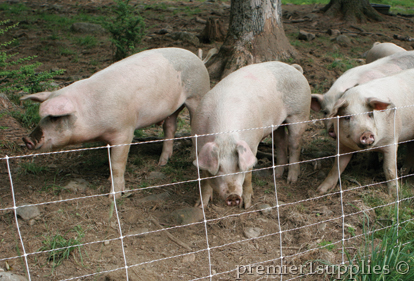
Pigs can quickly till the soil, so plan for frequent moves using our Pig QuikFence™, which makes moving locations easy to accomplish. The result can be an excellent pretilled garden.
Before you buy or build a fence
Q. What is the fence’s location? Is it flat? Or does it go over hills and ditches and around curves? Is it covered with brush, trees or open grass? Are the soils rocky, very soft, sandy or firm?
A.The optimum fence design often hinges on answers to these questions.
Q. Do the animals know the fence?
A. Local animals and wildlife get to “know” a fence by appearance, location and “pain memory.” If it’s a strong or painful fence they avoid it. On the other hand new animals just off a truck often charge into permanent fences and straight through temporary or semi-permanent fences. That’s why strong, tall, visible permanent fences are essential for corrals and feedlots. Temporary fences that are not physically strong pose the greatest risk of escape to newly acquired animals. It pays to train them to it inside of a permanent fence.
Q. What specific animals need to be fenced in or out?
A. Always design and build for the most difficult species. Rules of thumb:
| • |
Most sheep and goat fences will stop swine. The inverse is not always true. |
| • |
Fencing adult males (bulls, rams, boars, billies) in/out during breeding season requires taller fences with closer wire/strand spacing and more powerful electric pulses (in joules, not volts) |
| • |
Fences for mixed sizes (sows with piglets, etc.) need more strands than uniform animal groups. |
Q. Should you energize the fence?
A. It pays to do this. Why?
| • |
A “hot” strand has a “zone of pain.” So fewer strands are needed if one is energized. Both the material and the labor to install is reduced. |
| • |
Energized fences last longer and require less maintenance—because animals do not crowd, rub or scratch on them. So the fence wires (including wires that are not energized) require less tension to do their job. And braces and corner posts will last longer. |
| • |
Animals are more surely contained or excluded during breeding and weaning. |
Q. How keen will animals be to breach the fence line?
A. Build for the worst-case situation (if you can afford to do so).
Some situations that require more secure fences:
| • |
Hunger. Starved animals will eventually challenge most fences. |
| • |
Weaning. Strong physical barriers are needed. |
| • |
Breeding. Libido induces all creatures to challenge rules and especially fences. |
| • |
Boredom. Animals in corrals, stalls and feedlots crave any “entertainment” or activity. |
| • |
Gateways and handling yards. Animals often push each other into fences when being moved. |
| • |
Fear and fright. Predators or loud noises can cause “prey” species (e.g. horses, goats, turkeys) to run in terror straight into, under, over or through any fence, no matter what fence design (netting, high-tensile or woven wire). |
FENCING SWINE IN AND OUT
Domestic Pigs…
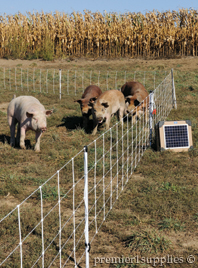
Grazing with pasture pigs is done easily with Pig QuikFence™ and a PRS Solar Energizer. The lowest electrified strand of QuikFence is 6" above the ground, thus reducing grass contact and enabling a smaller energizer to be used.
|
Contains pigs in the backyard or pasture rather than a cement lot. Prefabricated. So it’s easier to use and install than multiple strands of electric wire on posts (and far more effective and reliable as well).
Pig QuikFence™ 6/30/12
Uses
| • |
As a perimeter or subdivision fence for pasture pigs. |
| • |
Around gardens, orchards and fields, allowing pigs to forage after harvest. |
| • |
To replace welded wire panels, which are heavy and not easy to move. Pig QuikFence is much lighter than hog panels. And you can make a much larger pen for less $$. |
Training pigs to electric fence…
If your pigs have not previously been trained to electric fence, you definitely should do this first.
| • |
Why? Because pigs new to electric fence may decide to charge forward through the fence instead of backing away. |
| • |
How? Set up an electric fence alongside (1 to 2 ft away) a secure permanent fence that the pigs can’t get through. Make sure the electric fence is “on” (at least 3000v at end of fence). Introduce the pigs to the fence. Monitor the pigs for a few hours. |
Note: It's essential to train domestic pigs to electric fences. Failing to do so can be expensive (damage to the fence plus the damage the escaped pigs might create).
The Hog Problem…
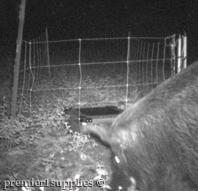
Photo taken with a trail camera. Feral hogs avoided the baited test site for a few days after Pig QuikFence (6/30/12) was installed. Eventually they approached it—and found a way to “conquer” this design. As a result we modified the fence. The result is Feral HogNet 10/24/12—shorter with more live wires.
|
As those who live in wild hog country know only too well, feral hog populations are growing rapidly.
Regrettably, wild hogs are as smart as they are aggressive and destructive. It’s common for them to find ways through, under or over physical barrier fences. It’s been proven that electrified fences work and work well to deter wild hogs. Why? Because hogs use their moist nose/snout to test and investigate new situations.
The bare nose ensures that contact with an energized strand will send a hog-stopping pulse (if the energizer is large enough) through the hog. Hogs have very good memories and aren’t likely to test the same fence twice—if the pulse was painful enough the first time they touched it.
Feral HogNet™ 4/18/12
A strutted net with 3 electrified horizontal strands. Bottom strand rests on the ground. Best for green grass and moist soil.
Premier's Experiment—Feral HogNet™ 10/24/12
We experimented with domestic Pig QuikFence for stopping feral hogs in Alabama 3 years ago. An experimental net was installed around a baited site that wild hogs frequented. It worked for 10 days—and then failed.
Why? 2 causes:
| 1. |
The spaces under the suspended lower wire were too large (6")—allowing the hogs to reach under the fence with their snouts to reach the corn immediately inside the barrier. |
| 2. |
Hogs are infamous for surging forward instead of backward when shocked by an electric fence.
|
When the lead hog pushed its nose under the fence to reach the corn, it received a shock—and reacted by charging forward, taking the net with it. So we modified the netting design to prevent feral hogs from poking their snouts under or through the electric netting before receiving a shock.
HogNet 10/24/12 is the result…
It can be used to keep hogs out of gardens, lawns, fields and pastures. HogNet is 24" tall. (Hogs can’t jump, so it does not have to be tall.) Has strutted verticals and 10 horizontal strands. Bottom strand is neutral and rests on the soil/grass. Lowest live strand is only 4" above it. The next 6 live wires are only 2" apart. It can be easily changed to a Pos/Neg system if/when the soil becomes dry.
The fence is as visible to hogs at night as possible (contrasting black and white).
Why is Feral HogNet less expensive than other netting?
Because we’re looking for folks with hog problems who will try it and report their results to us. (If it does not work for you, ship the product back to us for a refund.)
We will keep the price low until we can no longer afford to lose money doing this!
|
|